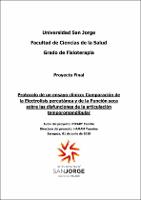Por favor, use este identificador para citar o enlazar este ítem:
https://repositorio.usj.es/handle/123456789/193
| Título : | Protocolo de un ensayo clínico: Comparación de la Electrolisis percutánea y de la Punción seca sobre las disfunciones de la articulación temporomandibular |
| Autor: | Picart, Camille |
| Palabras clave : | Síndrome de dolor miofascial; Puntos gatillos miofasciales; Disfunción temporomandibular; Electrolisis percutánea músculo esquelética; Punción seca profunda; Músculo pterigoideo lateral; Músculo masetero |
| Fecha de publicación: | 2019 |
| Resumen : | Introducción: El síntoma prevalente de las disfunciones temporomandibulares es el dolor muscular, que se asocia a menudo al síndrome de dolor miofascial (SDM). Se traduce en mayor parte por la presencia de puntos gatillos miofasciales (PGM). Ninguna investigación ha evaluado la efectividad de la electrolisis percutánea músculo esquelética (EPME) sobre el mecanismo de inactivación de PGM a corto y largo plazo. Objetivo: Comparar la efectividad de terapia de ejercicios mandibulares (TEM) combinada con tres intervenciones EPME, PSP y punción seca simulada (PSS), sobre la percepción subjetiva del dolor mediante la Escala Visual Analógica (EVA) de los pacientes diagnosticados con disfunciones de ATM sobre los músculos masticadores, pterigoideo lateral y masetero unilateral. Material y método: Los pacientes, diagnosticados con disfunciones de ATM, serán reclutados al Hospital Universitario Miguel Servet de Zaragoza. Estarán repartidos aleatoriamente en tres grupos iguales: grupo experimental 1 (PSP), grupo experimental 2 (EPME) y el grupo control (PSS). Las sesiones de tratamiento se efectuarán una vez a la semana durante tres semanas. Además, harán una sesión de TEM, dos veces a la semana. Las valoraciones de medición se realizaran antes de cada sesión de intervención, y después del periodo de tratamiento (+3 meses, +6 meses, +12 meses, +18 meses). Resultados esperados: A corto y largo plazo, se espera obtener una mejoría del dolor (al reposo, durante la masticación), un aumento del rango de movimiento (apertura bucal, protrusión, lateralización), un aumento del PPT y una mejoría de la puntuación del cuestionario CF-PDI. Conclusión: Se espera demostrar que la EPME puede ser más efectiva, en comparación con PSP y PSS, para tratar los PGM en pacientes afectados por disfunciones de ATM, a corto y largo plazo. |
| Descripción : | The main symptom of the temporomandibular dysfunction is the muscular pain, it often comes with the miofascial pain syndrome (SDM). It is characterized for the most part by the presence of myofascial trigger points (PGM). There is no investigation that evaluate the effect of the musculoskeletal percutaneous electrolysis (EPME) on the deactivation mechanism of the PGM in the short and long term. Objective: Compare the effectiveness of three different technics combined with the mandibular exercise therapy (TEM) on the subjective perception of the pain measured with the visual analog scale (EVA). Those three technics are, EPME, PSP and simulated dry needling (PSS). The patients have ATM issues on the lateral pterygoid muscle, masseter muscle and the masticatory muscles. Material and methods: The patients diagnosed with ATM issues will be recruted in the Hospital Universitario Miguel Servet of Zaragoza. They will be separated within three identical groups: experimental group 1 (PSP), experimental group 2 (EPME) and the control group (PSS). Treatment session will be one time by week for three week. Moreover, they will follow 2 sessions of TEM by week. The outcomes measures will be done before every treatment sessions and after the treatment (+3 months, +6 months, +12 months, +18 months). Expected Results: We hope that in the short and long term we will observe improvements in pain (at rest and during mastication), improvement of the motion range (mouth opening, protrusion, lateralization) and an PPT increase and improvements regarding the CF-FDI quiz. Conclusion: We hope that EPME will be more efficient that the PSP and PSS technics in order to treat PGM on the patients with ATM issues in the short and long term. |
| URI : | https://repositorio.usj.es/handle/123456789/193 |
| Aparece en las colecciones: | Grado en Fisioterapia |
Ficheros en este ítem:
| Fichero | Descripción | Tamaño | Formato | |
|---|---|---|---|---|
| Protocolo de un ensayo clínico.pdf | 1,27 MB | Adobe PDF |  Visualizar/Abrir |
Este ítem está sujeto a una licencia Creative Commons Licencia Creative Commons

